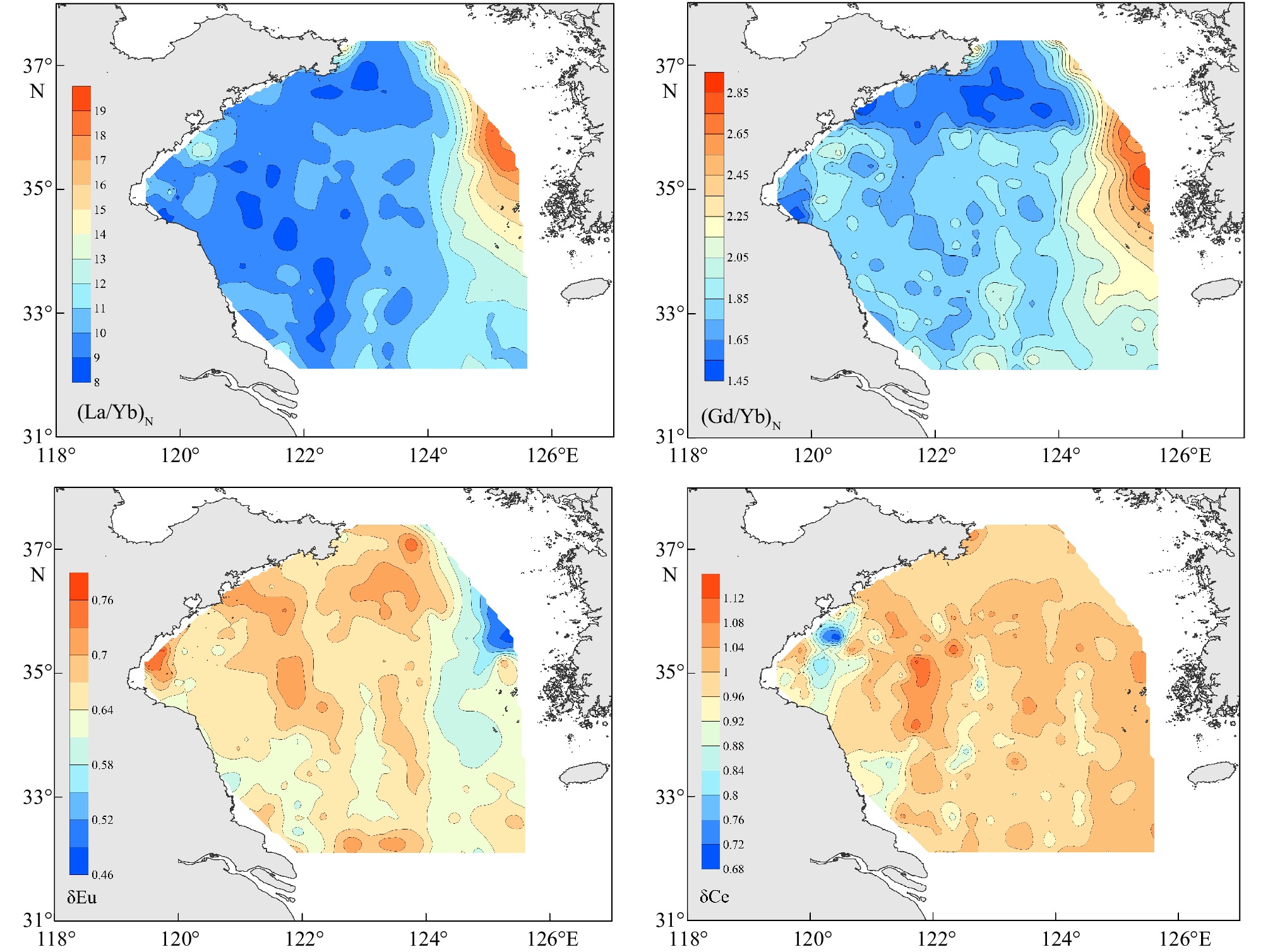Distribution of rare earth elements in surface sediments of the South Yellow Sea and its implication to sediment provenances
-
摘要: 对南黄海表层沉积物稀土元素数据进行了系统总结,旨在揭示其赋存特征、分布规律及主要来源。结果表明,南黄海稀土元素含量为77.2~261.78 μg/g,平均值为166.46 μg/g;空间上分布规律显著,高值区出现在南黄海中部泥质区,含量基本在180 μg/g以上,而低值区则呈斑块状出现在靠近山东半岛近岸一带,含量多低于130 μg/g。稀土元素的球粒陨石配分模式和上陆壳(UCC)配分模式显示各海域总体特征较为一致,与中国大陆的稀土元素配分曲线类似,指示了较强的陆源特征,河流携带的陆源入海物质是其主要的物质来源。通过对稀土元素各特征参数进行相关性分析,发现南黄海稀土元素组成与沉积物粒度呈较为明显的正相关,表明了沉积物粒度、矿物组成对稀土元素含量具有显著的控制作用。对比分析稀土元素空间分布规律和南黄海主要入海河流沉积物稀土组成,结果表明南黄海绝大部分沉积物来自于中国大陆河流,包括长江、黄河和老黄河等大型河流。在不同环流体系控制下,大型入海河流控制了南黄海不同区域的物质分布:西北部主要来自黄河入海物质,山东半岛沿岸流是其主要输运动力;老黄河物质主要沉积在西部海域,主要驱动力是苏北沿岸流;南部物质主要来自长江入海物质,长江冲淡水和闽浙沿岸流控制了其分布范围;东部近岸区域则以朝鲜半岛入海河流携带陆源物质为主,主要输运动力为朝鲜沿岸流。在此基础上,以La/Yb=11.7为界,可将整个南黄海划分为两个物源区,西部大部分海域为中国大陆来源,而东部近岸区则为朝鲜半岛来源,两者分界线基本接近于黄海海槽的位置。总体而言,大中型河流带来的陆源物源、沉积物粒度以及海域流系格局控制了南黄海表层沉积物稀土元素的组成特征和分布格局。Abstract: To reveal their compositions, distributions, and provenances of rare earth elements in the sediment from the South Yellow Sea, the data in the surface sediments in the area were studied systematically. The results show that the content of rare earth elements ranged from 77.2 to 261.78 μg/g, with the average value of 166.46 μg/g. The spatial distribution pattern of rare earth element is distinct, showing relative higher value in the muddy area in the central of the South Yellow Sea, where the content is generally more than 180 μg/g, while the lower value area appears as patches close to the coastal regions of Shandong Peninsula, and the content is mostly less than 130 μg/g. The normalized rare earth elements patterns of chondrite and upper continental crust (UCC) show overall pictures of the entire study area, which is similar to the distribution pattern of rare earth elements in Chinese mainland, indicating clear terrigenous imprint of riverine materials, reflecting the intimacy as the main sediment provenance of the South Yellow Sea. Meanwhile, as shown in the correlation analysis of the characteristic parameters of rare earth elements, the composition of rare earth elements in the South Yellow Sea is significantly positively correlated with the grain size of sediments, indicating that the sediment grain size and mineral composition controlled the content and composition of rare earth elements in the study area. Based on the spatial distribution pattern of rare earth elements and those from the main rivers into the South Yellow Sea, we believed that the sediment of South Yellow Sea is mainly from the Chinese large rivers, including Yangtze River, modern Yellow River, and old Yellow River. The northwest part is mainly from the Yellow River materials, and the coastal current of Shandong Peninsula is its main transport power. The material of the old Yellow River mainly deposit in the west of the South Yellow Sea, and the main driving force is the coastal current of Jiangsu Province. The material in the southern part of the South Yellow Sea mainly come from the material entering the sea from the Yangtze River, which is controlled by the Yangtze River diluted water and the coastal current of Fujian and Zhejiang. The east coast of the South Yellow Sea is dominated by terrestrial materials carried by the rivers in the Korean Peninsula, and the main transport power is the Korean coastal current. Taking La/Yb=11.7 as the demarcation line, the entire South Yellow Sea can be divided into two realms. Most of the western materials are from Chinese mainland, while the eastern coastal area from the Korean Peninsula. The boundary between these two realms is close to the middle line of the Yellow Sea trough. Therefore, we confirm that the terrestrial provenance, sediment grain size, and marine current system pattern control the composition and distribution pattern of rare earth elements in the surface sediments of the South Yellow Sea.
-
Keywords:
- surface sediment /
- rare earth elements /
- provenance /
- South Yellow Sea
-
天然气水合物是在低温高压环境下由水和天然气(主要是甲烷)形成的笼形结晶化合物[1]。由于其潜在的巨大规模储量(约3000万亿m3)和清洁的燃烧产物,天然气水合物被视为很有前景的未来能源[2-4]。另一方面,天然气水合物中的甲烷是一种温室效应高于CO2二十多倍的温室气体,因此由于温压条件变化而导致的天然气水合物分解释放出的大量甲烷会对全球气候造成影响[5-8]。因此对于天然气水合物的研究具有重大的意义。
沉积物孔隙水地球化学研究作为海洋沉积研究最主要的手段之一,在天然气水合物的研究当中发挥了非常重要的作用,在天然气水合物异常识别、成藏流体来源、流体运移过程以及流体组分在浅表层微生物地球化学过程的响应等方面取得了大量研究成果[2, 9-15]。如用氯离子和氧同位素异常来识别水合物赋存[2, 16-18],用硫酸根梯度(或硫酸盐还原带深度)结合溶解无机碳(Dissolved Inorganic Carbon,DIC)含量及其同位素组成来识别AOM(Anaerobic Oxidation of Methane,AOM)过程等[10, 12, 19-21]。在南海北部陆坡天然气水合物勘探研究中,孔隙水地球化学在水合物成藏对浅表层沉积物早期成岩作用过程的影响的研究中扮演了非常重要的角色,并取得了很多成果[15, 16, 19, 22-24]。南海北部陆坡潜在水合物远景区均表现出可能与天然气水合物相关的地球化学异常特征,主要表现为浅表层沉积物中较浅的SMI(Sulfate-Methane Interface,SMI)界面、相对偏负的溶解无机碳的碳同位素组成以及其他主微量元素特征等[17, 19, 20, 22, 23, 25-28]。但由于取样限制,大部分报道的工作集中于浅表层,主要的分析结果均是间接证据,真正与水合物直接相关的孔隙水地球化学研究较少。而南海北部地区GMGS1-GMGS3三次的水合物钻探计划为我们的研究提供了基础。
本次研究选取了GMGS2航次的GMGS2-09站位作为研究对象,分析直接与水合物相关的孔隙水地球化学特征,利用地球化学异常识别水合物的赋存并计算水合物在孔隙介质之间的饱和度。
1. 地质背景
南海是西太平洋最大的边缘海之一,其北部陆坡区地形复杂,许多大中型新生代沉积盆地(台西南盆地、珠江口盆地、琼东南盆地和莺歌海盆地等)跨越了陆坡区,最大沉积厚度超过10000m。晚更新世和全新世地层沉积速率分别为17.9~19.6cm/ka和9.6~14.6cm/ka[29]。北部陆坡的水深为200~3400m,水温为2~5℃,较快的沉积速率和适宜的温压条件都非常有利于天然气水合物的形成[30]。
中国自20世纪90年代开展天然气水合物的调查研究以来,已在南海北部陆坡圈定了一系列成矿远景区[17, 18, 31-34]。在南海北部的神狐海域,广州海洋地质调查局于2007年实施了首次天然气水合物钻探航次GMGS1,钻获分散状天然气水合物实物样品[17],并于2015年的GMGS3钻探航次中再次钻获多种类型水合物[35]。2013年,在神狐海域东北部的珠江口盆地东南海域,实施了GMGS2钻探航次,首次钻获了纯块状天然气水合物岩芯样品,并且还有大量层状、块状、结核状及分散状等多种形态的天然气水合物实物样品[18]。2015年在琼东南海域海马冷泉区,发现并采获了浅表层水合物[36]。最终于2017年,中国地质调查局在神狐海域成功实施了天然气水合物试开采,也是国际上首次对细粒沉积物储层实现试采[37]。
2. 样品及分析方法
本文研究的GMGS2钻探位置位于南海北部陆坡珠江口盆地与台西南盆地间(图 1)。其中在GMGS2-05、GMGS2-07、GMGS2-08、GMGS2-09、GMGS2-16等5口井发现水合物实物样品。测井曲线结果显示除了GMGS-08、GMGS-16站位有浅层和深部两层水合物外,其他站位仅发育单层水合物[38]。GMGS2-09井水深664m,钻井深度近110 m,在9~21m层段发育有结核状水合物[38]。GMGS2-09井位在钻探现场采用压榨法提取孔隙水样品13份,样品从8.65m到100.16m连续分布,每份孔隙水取样岩心厚度约3cm。
针对研究需要对GMGS2-09井的孔隙水进行了氯离子含量、氢氧同位素和阳离子的分析,所有分析均在南京大学内生金属矿床成矿机制研究国家重点实验室完成。
氯离子含量采用滴定法测定,使用0.1M硝酸银溶液为滴定液,监测标准为IAPSO国际海水标准,使用仪器为瑞士Metrohm的916 Ti-Touch全自动点位滴定仪,电极为复合银电极,分析相对误差低于1%。硫酸根含量采用离子色谱法,使用瑞士Metrohm公司790-1型通用离子色谱仪,Metrosep A Supp4-250型阴离子柱, 相对标准偏差小于3%。
氢氧同位素采用TC/EA-IRMS法测定,分析仪器为FLUSH2000元素分析仪和MAT253型稳定同位素质谱(ThermoFisher, Germany),使用标准为VSMOW、SLAP、GISP国际氢氧同位素标准,氧同位素分析精度优于0.2‰,氢同位素分析精度优于1‰。
孔隙水的阳离子含量采用离子色谱法,使用瑞士Metrohm公司790-1型通用离子色谱仪,Metrosep C 2-150型阳离子柱。相对标准偏差小于3%。
3. 结果
GMGS2-09站位沉积物孔隙水阴阳离子浓度随深度变化特征如图 2所示。从图中可以看到,氯离子含量从顶到底在正常层位其含量基本稳定,分布在580mM左右。而在水合物赋存层位A区则表现出了较为明显的负漂移,另外在B、C区也出现了明显负漂移迹象。
钾和钠离子随深度变化相较于氯离子变化较大,但在A、B、C等水合物存在或者疑似存在的层位也都出现了较为明显的浓度降低情况。除3个异常层位外,整体上钠和钾离子呈现出浓度随深度降低的趋势。镁、钙离子与钾、钠离子表现基本相同,其中钙离子在10m以下含量基本稳定。
GMGS2-09站位氢氧同位素组成如图 3所示,氢氧同位素随深度变化较大,氧同位素值普遍较高,相较以往珠江口盆地东南海域浅表层沉积物孔隙水的值高0.1‰~0.4‰[40],但在阴阳离子异常区域仍然可以看出氧同位素相对于上下层位有较为明显的高异常,氢同位素值变化也具有类似特征。
4. 讨论
4.1 GMGS2-9站位水合物层位的识别
由排盐作用引起的盐度异常和水合物结晶引起的氢氧同位素分馏是天然气水合物研究最直接的地球化学异常现象。氯离子浓度负异常耦合氧同位素正异常是天然气水合物形成后分解的最佳证据[2, 41],或者反之氯离子正异常、氧同位素负异常则被认为是天然气水合物形成的证据,总体上来说在有天然气水合物存在的区域两者应该呈负相关关系。
GMGS2-09站位沉积物孔隙水地球化学特征显示了较为明显的盐度异常以及氢氧同位素异常。如图 4所示,部分出现氯离子含量低异常的层位,其氢氧同位素也表现出了较为明显的异常。但是从图中也可以看出,氧同位素与氯含量并没有呈现出理想的负相关关系,可能是由于沉积物原位孔隙水中氯含量以及氧同位素值初始含量或组成存在差异。
沉积物孔隙水的地球化学异常是相对于相邻层位正常沉积物孔隙水而言,不是与海水比较。由于沉积环境不同(如沉积速率、沉积厚度、热流以及构造等),不同区域的沉积物孔隙水特征会有不同程度的差别,也会使其偏离海水的数值[2, 42, 43]。如ODP 164航次994、997站位,其氯含量与氧同位素组成均随着深度呈现下降趋势,该现象受制于深部流体的地球化学特征影响[44]。因此我们在对氯离子浓度和氢氧同位素异常进行判别时首先需要对其背景进行校正,先使用非水合物储层的数据进行曲线拟合,然后根据水合物层的拟合值与真实测定值来求出该区域的地球化学异常值并进行图解判别。
通过对GMGS2-09站位的沉积物孔隙水各离子浓度曲线进行了基线拟合(排除图 2所示的含量异常点),然后根据拟合值对其差异进行校正,我们得到氯含量以及氧同位素的异常值(图 5)。
对比数据校正前后的变化可以看出校正后前文所述的三层异常层表现出明显的氯低异常和氧同位素正异常的耦合关系,确证了GMGS2-09井在9~17、47以及100m处水合物的存在,其中9~17m层位与实际取样结果完全一致,也与测井曲线结果吻合[38]。中下两层对应的测井曲线并未出现异常,可能与这两层水合物的赋存形态及含量有关。浅表层水合物以块状形式存在,在电阻率伽马等物理指标上会有较明显的显示,中下两层可能是以浸染状形式赋存,含量较低,测井曲线上特征不明显。
4.2 GMGS2-9站位水合物饱和度的估算
基于水合物晶格的排盐机理,取样时所观察到的氯离子负异常均来源于水合物分解产生的淡水稀释所致,因此可以用氯离子淡化程度来估算埋藏时水合物的饱和度[45] (公式1)。
$$ S_{\mathrm{h}}=\left[\beta\left(C_{\mathrm{b}}-C_\text{s}\right)\right] /\left[C_\text{s}+\beta\left(C_{\mathrm{b}}-C_{\mathrm{s}}\right)\right] $$ (1) 公式中Sh为水合物饱和度;Cb为沉积物原始层位孔隙水离子的背景浓度,一般采用原位测量来获取,但是由于原位测量存在困难,可以用基线拟合的背景浓度来代替;Cs为各层位的实测浓度;β为常数,用于校正水合物分解产生的流体密度变化,采用Malinverno等[45]的方法推算出的数据为1.257。
在用氯含量进行估算的同时,我们也用钾和钠含量进行了水合物饱和度的估算(图 6),在靠近海底的位置,三者的估算结果几乎完全一致,从17m处的20%左右到8.5m处的58%左右。在47m处,氯和钠离子估算值较为接近,均为13%左右,钾离子估算值为31%。在底部100m处,钾和钠离子相当,为20%左右,而氯离子估算结果为48%。从估算结果可以看出,从9m到17m左右深度的水合物含量最高,这与实际采样时在该层位发现结核状水合物的情况相吻合。而估算结果也表明,47m及100m处可能存在相当含量的水合物赋存,尤其是100m处。
图中三者对水合物饱和度的估算也表现出了一定程度的差异,可能来自三种离子自身地球化学性质的差异。钾和钠离子相对于氯离子稳定性稍差,其含量仍会受到深部黏土矿物变质的影响。由于变化不同,在用数学方法拟合时,其精度和准确度也有差异。这个差异会表现在最终结果上。浅表层位置孔隙水的原始含量主要受控于海水,因此其拟合数据的准确度较高,因此三者之间的一致性也比较理想。
5. 结论
GMGS2-09站位位于珠江口盆地东南海域,在该站位钻探时多个层位发现有疑似水合物埋藏的迹象。通过对该站位孔隙水地球化学研究发现,在9、47以及100m三个层位存在水合物,三个层位均表现出氯含量的相对低异常和氢氧同位素的相对正异常。根据氯离子含量以及钠离子含量,我们对该站位的水合物饱和度进行了估算,浅表层最高约为50%,中间以及底层约为20%。浅表层相对较高的水合物饱和度估算结果也与钻探采样过程中在此深度发现结核状水合物的分布相吻合。
-
表 1 南黄海海域表层沉积物及周边入海河流沉积物稀土元素含量及特征参数
Table 1 REE content and characteristic parameters of surface sediments in the South Yellow Sea and surrounding rivers
∑REE / (μg/g) ∑LREE /(μg/g) ∑HREE /(μg/g) ∑LREE/
∑HREEδEu δCe (La/Yb)N (Gd/Yb) N 南黄海 最大值 261.78 235.72 24.41 13.728 0.78 1.14 19.18 2.85 最小值 77.19 70.54 6.07 7.30 0.46 0.67 8.26 1.46 平均值 166.46 148.99 16.28 9.18 0.65 0.99 10.51 1.86
河
流长江[26] 186.66 167.04 18.32 9.12 0.64 1.01 10.74 1.95 黄河[26] 148.08 131.87 15.24 8.65 0.60 1.00 9.68 1.84 汉江[25] 221.69 204.47 17.21 11.87 0.63 1.05 13.03 1.67 锦江[25] 225.20 207.48 17.73 11.71 0.71 1.04 13.28 1.72 荣山江[25] 202.90 186.34 16.56 11.25 0.76 1.05 12.30 1.68 表 2 南黄海稀土元素特征参数相关性分析
Table 2 Correlation analysis of rare earth element characteristic parameters in the South Yellow Sea
∑REE ∑LREE/∑HREE δEu δCe (La/Yb) N (La/Sm) N (Sm/Nd) N (Gd/Yb) N Mz ∑REE 1 ∑LREE/∑HREE 0.857** 1 δEu 0.297** −0.230** 1 δCe −0.564** −0.252** −0.619** 1 (La/Yb)n −0.105 −0.236** 0.232** 0.129 1 (La/Sm)n 0.299** −0.197** 0.961** −0.655** 0.087 1 (Sm/Nd)n 0.330** −0.010 0.639** −0.316** 0.052 0.630** 1 (Gd/Yb)n −0.417** −0.250** −0.315** 0.214** 0.031 −0.262** −0.352** 1 Mz 0.328** 0.404** −0.113 −0.029 −0.039 −0.070 −0.012 −0.031 1 -
[1] McLennan S M. Rare earth elements in sedimentary rocks: Influence of provenance and sedimentary processes [J]. Reviews in Mineralogy and Geochemistry, 1989, 21(1): 169-200.
[2] Cullers R L. The controls on the major and trace element variation of shales, siltstones, and sandstones of Pennsylvanian-Permian age from uplifted continental blocks in Colorado to platform sediment in Kansas, USA [J]. Geochimica et Cosmochimica Acta, 1994, 58(22): 4955-4972. doi: 10.1016/0016-7037(94)90224-0
[3] Munksgaard N C, Lim K, Parry D L. Rare earth elements as provenance indicators in North Australian estuarine and coastal marine sediments [J]. Estuarine, Coastal and Shelf Science, 2003, 57(3): 399-409. doi: 10.1016/S0272-7714(02)00368-2
[4] Liu S F, Zhang H, Zhu A M, et al. Distribution of rare earth elements in surface sediments of the western Gulf of Thailand: Constraints from sedimentology and mineralogy [J]. Quaternary International, 2019, 527: 52-63. doi: 10.1016/j.quaint.2018.08.010
[5] Murray R W, Buchholtzten Brink M R, Brumsack H J, et al. Rare earth elements in Japan Sea sediments and diagenetic behavior of Ce/Ce*: results from ODP Leg 127 [J]. Geochimica et Cosmochimica Acta, 1991, 55(9): 2453-2466. doi: 10.1016/0016-7037(91)90365-C
[6] 杨守业, 李从先, Lee C B, 等. 黄海周边河流的稀土元素地球化学及沉积物物源示踪[J]. 科学通报, 2003, 48(11):1135-1139 doi: 10.3321/j.issn:0023-074X.2003.11.004 YANG Shouye, LI Congxian, Lee C B, et al. REE geochemistry of suspended sediments from the rivers around the Yellow Sea and provenance indicators [J]. Chinese Science Bulletin, 2003, 48(11): 1135-1139. doi: 10.3321/j.issn:0023-074X.2003.11.004
[7] 窦衍光, 李军, 李炎. 北部湾东部海域表层沉积物稀土元素组成及物源指示意义[J]. 地球化学, 2012, 41(2):147-157 doi: 10.3969/j.issn.0379-1726.2012.02.006 DOU Yanguang, LI Jun, LI Yan. Rare earth element compositions and provenance implication of surface sediments in the eastern Beibu Gulf [J]. Geochimica, 2012, 41(2): 147-157. doi: 10.3969/j.issn.0379-1726.2012.02.006
[8] Mi B B, Liu S F, Shi X F, et al. A high resolution record of rare earth element compositional changes from the mud deposit on the inner shelf of the East China Sea: Implications for paleoenvironmental changes [J]. Quaternary International, 2017, 447: 35-45. doi: 10.1016/j.quaint.2016.09.056
[9] Milliman J D, Meade R H. World-wide delivery of river sediment to the oceans [J]. The Journal of Geology, 1983, 91(1): 1-21. doi: 10.1086/628741
[10] 程天文, 赵楚年. 我国主要河流入海径流量、输沙量及对沿岸的影响[J]. 海洋学报, 1985, 7(4):460-471 CHENG Tianwen, ZHAO Chunian. 1985. Runoff and sediment discharge into the sea of major rivers in China and their impact on the coast regions [J]. Acta Oceanologica Sinica, 1985, 7(4): 460-471.
[11] 杨作升, 王海成, 乔淑卿. 黄河与长江入海沉积物中碳酸盐含量和矿物颗粒形态特征及影响因素[J]. 海洋与湖沼, 2009, 40(6):674-681 doi: 10.3321/j.issn:0029-814X.2009.06.002 YANG Zuosheng, WANG Haicheng, QIAO Shuqing. Carbonate minerals in estuary sediments of the Changjiang (Yangtze River) and Huanghe (Yellow River): the content, morphology, and influential factors [J]. Oceanologia et Limnologia Sinica, 2009, 40(6): 674-681. doi: 10.3321/j.issn:0029-814X.2009.06.002
[12] 秦蕴珊, 郑铁民.. 黄东海地质[M]. 北京: 科学出版社, 1982 QIN Yunshan, ZHENG Tiemin. Geology of the Yellow Sea and East China Sea[M]. Beijing: Science Press, 1982.
[13] 石学法, 刘升发, 乔淑卿, 等. 中国东部近海沉积物地球化学: 分布特征、控制因素与古气候记录[J]. 矿物岩石地球化学通报, 2015, 34(5):885-894 SHI Xuefa, LIU Shengfa, QIAO Shuqing, et al. Geochemical characteristics, controlling factor and record of paleoclimate in sediments from eastern China Seas [J]. Bulletin of Mineralogy, Petrology and Geochemistry, 2015, 34(5): 885-894.
[14] Dou Y G, Yang S Y, Liu Z X, et al. Provenance discrimination of siliciclastic sediments in the middle Okinawa Trough since 30 ka: Constraints from rare earth element compositions [J]. Marine Geology, 2010, 275(1-4): 212-220. doi: 10.1016/j.margeo.2010.06.002
[15] 密蓓蓓, 王中波, 仇晓华, 等. 中全新世以来冲绳海槽氧化还原环境重建及其气候效应[J]. 海洋地质与第四纪地质, 2019, 39(4):107-115 MI Beibei, WANG Zhongbo, QIU Xiaohua, et al. Reconstruction of the redox environment in Okinawa Trough and its climatic implications since mid-Holocene [J]. Marine Geology & Quaternary Geology, 2019, 39(4): 107-115.
[16] Lim D I, Choi J Y, Jung H S, et al. Recent sediment accumulation and origin of shelf mud deposits in the Yellow and East China Seas [J]. Progress in Oceanography, 2007, 73(2): 145-159. doi: 10.1016/j.pocean.2007.02.004
[17] Liu J, Saito Y, Wang H, et al. Sedimentary evolution of the Holocene subaqueous clinoform off the Shandong Peninsula in the Yellow Sea [J]. Marine Geology, 2007, 236(3-4): 165-187. doi: 10.1016/j.margeo.2006.10.031
[18] 密蓓蓓, 张勇, 梅西, 等. 中国东部海域表层沉积物稀土元素赋存特征及物源探讨[J]. 中国地质, 2020, 47(5):1530-1541 MI Beibei, ZHANG Yong, MEI Xi, et al. The rare earth element content in surface sediments of coastal areas in eastern China’s sea areas and an analysis of material sources [J]. Geology in China, 2020, 47(5): 1530-1541.
[19] 胡邦琦, 杨作升, 赵美训, 等. 南黄海中部泥质区7200年以来东亚冬季风变化的沉积记录[J]. 中国科学:地球科学, 2012, 55(10):1656-1668 doi: 10.1007/s11430-012-4447-7 HU Bangqi, YANG Zuosheng, ZHAO Meixun, et al. Grain size records reveal variability of the East Asian Winter Monsoon since the Middle Holocene in the Central Yellow Sea mud area, China [J]. Science China Earth Sciences, 2012, 55(10): 1656-1668. doi: 10.1007/s11430-012-4447-7
[20] Lu J, Li A C, Zhang J, et al. Yangtze River-derived sediments in the southwestern South Yellow Sea: Provenance discrimination and seasonal transport mechanisms [J]. Journal of Asian Earth Sciences, 2019, 176: 353-367. doi: 10.1016/j.jseaes.2019.03.007
[21] Jung H S, Lim D, Jeong D H, et al. Discrimination of sediment provenance in the Yellow Sea: Secondary grain-size effect and REE proxy [J]. Journal of Asian Earth Sciences, 2016, 123: 78-84. doi: 10.1016/j.jseaes.2016.03.020
[22] Lim D, Jung H S, Choi J Y. REE partitioning in riverine sediments around the Yellow Sea and its importance in shelf sediment provenance [J]. Marine Geology, 2014, 357: 12-24. doi: 10.1016/j.margeo.2014.07.002
[23] Yang S Y, Jung H S, Lim D I, et al. A review on the provenance discrimination of sediments in the Yellow Sea [J]. Earth-Science Reviews, 2003, 63(1-2): 93-120. doi: 10.1016/S0012-8252(03)00033-3
[24] 朱赖民, 杜俊民, 张远辉, 等. 南黄海中部E2柱样沉积物来源的稀土元素及微量元素示踪[J]. 环境科学学报, 2006, 26(3):495-500 ZHU Laimin, DU Junmin, ZHANG Yuanhui, et al. Tracing the sediment source at E2 hole in the South Yellow Sea with rare earth element and trace element [J]. Acta Scientiae Circumstantiae, 2006, 26(3): 495-500.
[25] Xu Z K, Lim D, Choi J, et al. Rare earth elements in bottom sediments of major rivers around the Yellow Sea: Implications for sediment provenance [J]. Geo-Marine Letters, 2009, 29(5): 291-300. doi: 10.1007/s00367-009-0142-x
[26] Yang S Y, Jung H S, Choi M S, et al. The rare earth element compositions of the Changjiang (Yangtze) and Huanghe (Yellow) river sediments [J]. Earth and Planetary Science Letters, 2002, 201(2): 407-419. doi: 10.1016/S0012-821X(02)00715-X
[27] 赵一阳, 鄢明才. 中国浅海沉积物地球化学[M]. 北京: 科学出版社, 1994 ZHAO Yiyang, YAN Mingcai. Geochemistry of Sediments of the China Shelf Sea[M]. Beijing: Science Press, 1994.
[28] 王金土. 黄海表层沉积物稀土元素地球化学[J]. 地球化学, 1990(1):44-53 doi: 10.3321/j.issn:0379-1726.1990.01.005 WANG Jintu. REE geochemistry of surficial sediments from the Yellow Sea of China [J]. Geochimica, 1990(1): 44-53. doi: 10.3321/j.issn:0379-1726.1990.01.005
[29] 赵志根, 高良敏. δEu、δCe计算方法的标准化问题[J]. 标准化报道, 1998, 19(5):23-25 ZHAO Zhigen, GAO Liangmin. Discussion about standardization of methods to calculate δEu、δCe [J]. Reporting of Standardization, 1998, 19(5): 23-25.
[30] 秦蕴珊, 赵一阳, 陈丽蓉, 等. 东海地质[M]. 北京: 科学出版社, 1987 QIN Yunshan, ZHAO Yiyang, CHEN Lirong, et al. Geology of the East China Sea[M]. Beijing: Science Press, 1987.
[31] 蒋富清, 周晓静, 李安春, 等. δEuN-ΣREEs图解定量区分长江和黄河沉积物[J]. 中国科学D辑:地球科学, 2009, 52(2):232-241 doi: 10.1007/s11430-009-0018-y JIANG Fuqing, ZHOU Xiaojing, LI Anchun, et al. Quantitatively distinguishing sediments from the Yangtze River and the Yellow River using δEuN-ΣREEs plot [J]. Science in China Series D:Earth Sciences, 2009, 52(2): 232-241. doi: 10.1007/s11430-009-0018-y
[32] MacRae N D, Nesbitt H W, Kronberg B I. Development of a positive Eu anomaly during diagenesis [J]. Earth and Planetary Science Letters, 1992, 109(3-4): 585-591. doi: 10.1016/0012-821X(92)90116-D
[33] 杨守业, 李从先. REE示踪沉积物物源研究进展[J]. 地球科学进展, 1999, 14(2):164-167 doi: 10.3321/j.issn:1001-8166.1999.02.010 YANG Shouye, LI Congxian. Research progress in REE tracer for sediment source [J]. Advances in Earth Science, 1999, 14(2): 164-167. doi: 10.3321/j.issn:1001-8166.1999.02.010
[34] 严杰, 高建华, 李军, 等. 鸭绿江河口及近岸地区稀土元素的物源指示意义[J]. 海洋地质与第四纪地质, 2010, 30(4):95-103 YAN Jie, GAO Jianhua, LI Jun, et al. Implications of REE for provenance in the Yalu estuary and its adjacent sea area [J]. Marine Geology & Quaternary Geology, 2010, 30(4): 95-103.
[35] Caggianelli A, Fiore S, Mongelli G, et al. REE distribution in the clay fraction of pelites from the southern Apennines, Italy [J]. Chemical Geology, 1992, 99(4): 253-263. doi: 10.1016/0009-2541(92)90180-D
[36] Cullers R L, Barrett T, Carlson R, et al. Rare-earth element and mineralogic changes in Holocene soil and stream sediment: a case study in the wet mountains, Colorado, U. S. A. [J]. Chemical Geology, 1987, 63(3-4): 275-297. doi: 10.1016/0009-2541(87)90167-7
[37] 李俊, 弓振斌, 李云春, 等. 近岸和河口地区稀土元素地球化学研究进展[J]. 地球科学进展, 2005, 20(1):64-73 doi: 10.3321/j.issn:1001-8166.2005.01.012 LI Jun, GONG Zhenbin, LI Yunchun, et al. Marine geochemistry approaches of rare earth elements in coastal and estuarial areas [J]. Advances in Earth Science, 2005, 20(1): 64-73. doi: 10.3321/j.issn:1001-8166.2005.01.012
[38] 赵一阳, 李凤业, 秦朝阳, 等. 试论南黄海中部泥的物源及成因[J]. 地球化学, 1991(2):112-117 doi: 10.19700/j.0379-1726.1991.02.002 ZHAO Yiyang, LI Fengye, QIN Zhaoyang, et al. Source and genesis of mud in the central part of the South Yellow Sea in special reference to geochemical data [J]. Geochimica, 1991(2): 112-117. doi: 10.19700/j.0379-1726.1991.02.002
[39] 郭炳火, 黄振宗, 李培英, 等. 中国近海及邻近海域海洋环境[M]. 北京: 海洋出版社, 2004 GUO Binghuo, HUANG Zhenzong, LI Peiying, et al. Marine Environment in the Chinese Offshore Waters and Adjacent Sea Areas[M]. Beijing: Ocean Press, 2004.
[40] 苏纪兰. 中国近海的环流动力机制研究[J]. 海洋学报, 2001, 23(4):1-16 SU Jilan. A review of circulation dynamics of the coastal oceans near China [J]. Acta Oceanologica Sinica, 2001, 23(4): 1-16.
[41] Guan B X. Patterns and structures of the currents in Bohai, Huanghai and East China Seas[J]. Springer Netherlands, 1994: 17-26.
[42] 袁萍, 王厚杰, 毕乃双, 等. 中国东部陆架海锋面的时空变化及其对细颗粒沉积物输运和沉积的影响[J]. 海洋地质与第四纪地质, 2020, 40(3):25-42 doi: 10.16562/j.cnki.0256-1492.2019050602 YUAN Ping, WANG Houjie, BI Naishuang, et al. Temporal and spatial variations of oceanic fronts and their impact on transportation and deposition of fine-grained sediments in the East China Shelf Seas [J]. Marine Geology & Quaternary Geology, 2020, 40(3): 25-42. doi: 10.16562/j.cnki.0256-1492.2019050602
[43] 梅西, 李学杰, 密蓓蓓, 等. 中国海域表层沉积物分布规律及沉积分异模式[J]. 中国地质, 2020, 47(5):1447-1462 MEI Xi, LI Xuejie, MI Beibei, et al. Distribution regularity and sedimentary differentiation patterns of China seas surface sediments [J]. Geology in China, 2020, 47(5): 1447-1462.
[44] 蓝先洪, 王红霞, 张志珣, 等. 南黄海表层沉积物稀土元素分布与物源关系[J]. 中国稀土学报, 2006, 24(6):745-749 doi: 10.1016/S1002-0721(07)60021-0 LAN Xianhong, WANG Hongxia, ZHANG Zhixun, et al. Distributions of rare earth elements and provenance relations in the surface sediments of the South Yellow Sea [J]. Journal of the Chinese Rare Earth Society, 2006, 24(6): 745-749. doi: 10.1016/S1002-0721(07)60021-0
[45] 朱爱美, 刘季花, 张辉, 等. 东海内陆架泥质区表层沉积物稀土元素的分布特征[J]. 海洋地质与第四纪地质, 2012, 32(1):1-10 ZHU Aimei, LIU Jihua, ZHANG Hui, et al. Distribution pattern of REEs in the inner-shelf mud area of East China Sea [J]. Marine Geology & Quaternary Geology, 2012, 32(1): 1-10.
[46] 李文建, 王珍岩, 黄海军. 夏季南黄海悬浮体粒度分布及其影响因素[J]. 海洋地质与第四纪地质, 2020, 40(6):49-60 LI Wenjian, WANG Zhenyan, HUANG Haijun. Grain size distribution pattern and influencing factors of suspended matters in the Southern Yellow Sea during summer season [J]. Marine Geology & Quaternary Geology, 2020, 40(6): 49-60.
[47] 刘健, 秦华峰, 孔祥淮, 等. 黄东海陆架及朝鲜海峡泥质沉积物的磁学特征比较研究[J]. 第四纪研究, 2007, 27(6):1031-1039 doi: 10.3321/j.issn:1001-7410.2007.06.019 LIU Jian, QIN Huafeng, KONG Xianghuai, et al. Comparative researches on the magnetic properties of muddy sediments from the Yellow Sea and East China Sea shelves and the Korea strait [J]. Quaternary Sciences, 2007, 27(6): 1031-1039. doi: 10.3321/j.issn:1001-7410.2007.06.019
[48] Chough S K, Lee H J, Yoon S H. Marine Geology of Korean Seas[M]. 2nd ed. Amsterdam: Elsevier Science B. V. , 2000.
[49] Lee H J. A review on the Holocene evolution of an inner-shelf mud deposit in the southeastern Yellow Sea: the Huksan Mud Belt [J]. Ocean Science Journal, 2015, 50(4): 615-621. doi: 10.1007/s12601-015-0056-7
[50] Yang S Y, Youn J S. Geochemical compositions and provenance discrimination of the central south Yellow Sea sediments [J]. Marine Geology, 2007, 243(1-4): 229-241. doi: 10.1016/j.margeo.2007.05.001
[51] Schubel J R, Shen H T, Park M J. Comparative analysis of estuaries bordering the Yellow Sea[M]//Wolfe D A. Estuarine Variability. New York: Academic Press, 1986: 43-62.
-
期刊类型引用(2)
1. 赵竺栩,熊伟,王忠蕾,黄龙,密蓓蓓,王峻,梅西. 渤海海峡表层沉积物稀土元素的分布特征与物源判别. 海洋地质与第四纪地质. 2024(05): 151-160 .  本站查看
本站查看
2. 于世磊,朱龙海,胡日军,刘营,林超然. 北黄海南部近岸海域表层沉积物稀土元素分布特征及影响因素. 海洋地质前沿. 2024(12): 89-99 .  百度学术
百度学术
其他类型引用(3)




 下载:
下载:













